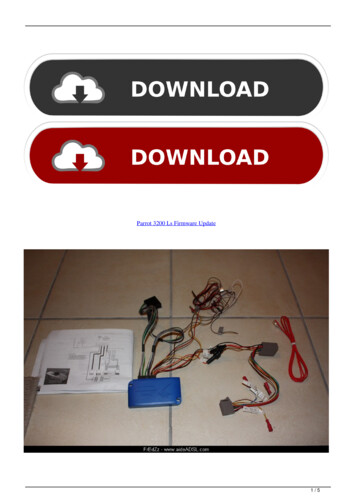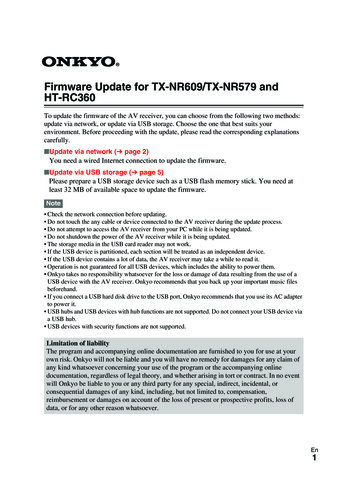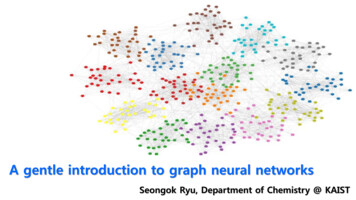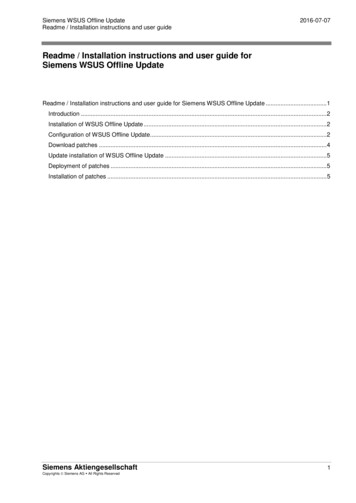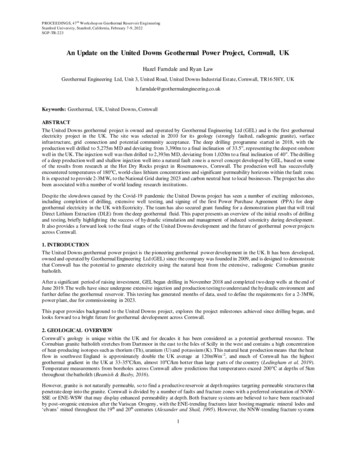
Transcription
P ROCEEDINGS, 47 th Workshop on Geothermal Reservoir EngineeringStanford University, Stanford, California, February 7-9, 2022SGP -TR-223An Update on the United Downs Geothermal Power Project, Cornwall, UKHazel Farndale and Ryan LawGeothermal Engineering Ltd, Unit 3, United Road, United Downs Industrial Estate, Cornwall, TR16 5HY, UKh.farndale@geothermalengineering.co.ukKeywords: Geothermal, UK, United Downs, CornwallABS TRACTThe United Downs geothermal project is owned and operated by Geothermal Engineering Ltd (GEL) and is the first geothermalelectricity project in the UK. The site was selected in 2010 for its geology (strongly faulted, radiogenic granite), surfaceinfrastructure, grid connection and potential community acceptance. The deep drilling programme started in 2018, with theproduction well drilled to 5,275m M D and deviating from 3,390m to a final inclination of 33.5 o, representing the deepest onshorewell in the UK. The injection well was then drilled to 2,393m M D, deviating from 1,020m to a final inclination of 40 o. The drillingof a deep production well and shallow injection well into a natural fault zone is a novel concept developed by GEL, based on someof the results from research at the Hot Dry Rocks project in Rosemanowes, Cornwall. The production well has successfullyencountered temperatures of 180oC, world-class lithium concentrations and significant permeability horizons within the fault zone.It is expected to provide 2-3M We to the National Grid during 2023 and carbon neutral heat to local businesses. The project has alsobeen associated with a number of world leading research institutions.Despite the slowdown caused by the Covid-19 pandemic the United Downs project has seen a number of exciting milestones,including completion of drilling, extensive well testing, and signing of the first Power Purchase Agreement (PPA) for deepgeothermal electricity in the UK with Ecotricity. The team has also secured grant funding for a demonstration plant that will trialDirect Lithium Extraction (DLE) from the deep geothermal fluid. This paper presents an overview of the initial results of drillingand testing, briefly highlighting the success of hydraulic stimulation and management of induced seismicity during development .It also provides a forward look to the final stages of the United Downs development and the future of geothermal power projectsacross Cornwall.1. INTRODUCTIONThe United Downs geothermal power project is the pioneering geothermal power development in the UK. It has been developed,owned and operated by Geothermal Engineering Ltd (GEL) since the company was founded in 2009, and is designed to demonstratethat Cornwall has the potential to generate electricity using the natural heat from the extensive, radiogenic Cornubian granitebatholith.After a significant period of raising investment, GEL began drilling in November 2018 and completed two deep wells at the end ofJune 2019. The wells have since undergone extensive injection and production testing to understand the hydraulic environment andfurther define the geothermal reservoir. This testing has generated months of data, used to define the requirements for a 2-3MWepower plant, due for commissioning in 2023.This paper provides background to the United Downs project, explores the project milestones achieved since drilling began, andlooks forward to a bright future for geothermal development across Cornwall.2. GEOLOGICAL OVERVIEWCornwall’s geology is unique within the UK and for decades it has been considered as a potential geothermal resource. TheCornubian granite batholith stretches from Dartmoor in the east to the Isles of Scilly in the west and contains a high concentrationof heat-producing isotopes such as thorium (Th), uranium (U) and potassium (K). This natural heat production means that the heatflow in southwest England is approximately double the UK average at 120mWm -2, and much of Cornwall has the highestgeothermal gradient in the UK at 33-35oC/km, almost 10oC/km hotter than large parts of the country (Ledingham et al. 2019).Temperature measurements from boreholes across Cornwall allow predictions that temperatures exceed 200 oC at depths of 5kmthroughout the batholith (Beamish & Busby, 2016).However, granite is not naturally permeable, so to find a productive reservoir at depth requires targeting permeable structures thatpenetrate deep into the granite. Cornwall is divided by a number of faults and fracture zones with a preferred orientation of NNWSSE or ENE-WSW that may display enhanced permeability at depth. Both fracture systems are believed to have been reactivatedby post-orogenic extension after the Variscan Orogeny, with the ENE-trending fractures later hosting magmatic mineral lodes and‘elvans’ mined throughout the 19th and 20th centuries (Alexander and Shail, 1995). However, the NNW-trending fracture systems1
Farndale and Lawform the ‘crosscourses’ which are less commonly mineralized and often observed in local mines to terminate economic lodes. Theycan be of considerable length and show significant movement on the order of hundreds of metres (Putrich et al. 2016; Hill et al.1906, Dines 1956). These crosscourses are aligned parallel to the regional maximum horizontal stress and therefore are believed tobe the most ‘open’ structures in southwest England, providing enhanced permeability (Brereton et al. 1991).3. THE UNITED DOWNS CONCEPTWhilst GEL has been working on the United Downs project since 2009, it is the natural progression of the original Cornish HotDry Rocks (HDR) project undertaken in the 1980s at Rosemanowes quarry. Rosemanowes was a pioneering research projectassociated with the Camborne School of M ines, designed to test and prove the theory of inducing a fracture network within theheat-producing granite to create a geothermal reservoir. It consisted of three phases:1. Drilling 300m boreholes to demonstrate that water circulation could be established between boreholes followinghydraulic stimulation of natural fractures.2. Investigation of reservoir development at 2km depth. Targets for a commercial system were set at 210 oC, flow rate of 100 l/s and maximum water loss of 10%.3.Investigation of techniques for enhancing the deep reservoir to improve its performance.Temperatures were significant but water losses of about 70% were observed during circulation. The analysis of microseismic eventlocations suggested that this high loss was associated with the downward growth of t he reservoir to depths of around 3 to 3.5 km(Parker 1999). It was clear that permeability and circulation at depth in the granite was achievable, but before this could be testedat greater depth and taking into account the water loss data, funding was pulled, and the project effectively shelved.In 2009, GEL picked up where Rosemanowes left off, identifying a more promising site on a significant permeability structure,and tweaking the well design to exploit this natural fracture network in a new way. The observations at Rosemanowes suggestedthat water injected would flow down through the fracture network, so GEL developed a system with a deep production well and ashallow injection well which penetrate the Porthtowan Fault Zone (Error! Reference source not found.).Drilling of directional wells UD-1 and UD-2 to measured depths of 5,275m and 2,393m, respectively, has successfully identifiedtemperatures of 180oC and significant mud-loss zones. This proves the presence of enhanced permeability and provides sufficienttemperature and flow for a binary power plant to generate electricity in the near future.Figure 1. S chematic of the geothermal doublet at United Downs, drilledinto the Porthtowan Fault Zone2
Farndale and Law4. PROJECT PROGRES SThe United Downs site was acquired by GEL in 2010 after a number of feasibility studies to find an appropriate site. It was s electedboth for its geological setting and its surface attributes with existing grid connection, close proximity to access roads and limitedanticipated impact on the local communities. Once all the relevant permits were secured, it then took five years to obtain theappropriate funding from a combination of the European Regional Development Fund, Cornwall Council and private investors,with the final funding agreements signed in 2017.Procurement and drilling took place throughout 2018-2019. Contracts for drilling and site equipment were tendered and awardedfollowing European guidelines. Drilling then started on 08 November 2018 with UD-1, the production well, and drilling of theinjection well started on 11 M ay 2019, reaching TD on 29 th June 2019. A summary of each well is provided in Error! Referencesource not found.Table 1. Key parameters for the wells at United DownsItemWell ClassificationUD-1UD-2Geothermal – Production WellGeothermal – Injection WellTargetCompletionPorthtowan Fault Zone8½” openhole8½” openholeReservoir Rock TypeTemperatureWell DepthCasing Depths (MDbGL)Granite188 C at 5,275m M DN/A5,275 m M D (5,057.6 m TVD bGL)2,393 m M D (2,214 m TVD bGL)18⅝” casing to 244.8 m13⅜” casing to 804 m13⅜” casing to 899 m9⅝” to 1,820 m9⅝” to 3,985 mFrom August 2020 to July 2021, both wells have undergone a series of injection tests to analyse the hydraulic environment of thereservoir and stimulate the near and far field to ultimately improve productivity/ injectivity. The purpose of this period of testingwas to: Define the injectivity of the fractures to gain a greater understanding of the character of the granite reservoir. Improve the injectivity of the reservoir using hydraulic stimulation to achieve sufficient flow rates to sustain the powerplant. M onitor any injection-induced seismicity to map the growth of the reservoir during stimulation. Understand safe flow rate levels (pressure and volume) to inform any future well treatment ‘Destress’ the reservoir to prevent microseismic events occurring during long term operationIn addition, in July 2021, full reservoir testing was undertaken for seven days. An Electrical Submersible Pump (ESP) was loweredto a depth of approximately 1km into UD-1 and coupled to injection pumps on UD-2 to simulate power plant operation and test theperformance of the whole reservoir. Successful testing enables GEL to move forward with the purchase of a power plant, withcommissioning anticipated in 2023.Beyond work onsite, throughout drilling and testing a number of research projects have been associated with the United Downsgeothermal project to help further the understanding of the resource and apply lessons learnt more generally to geothermal sy stemsin fractured granite. Research projects include Science for Clean Energy (S4CE) – EU Horizon 2020, Geothermal Power Generatedfrom UK Granites (GWatt) – UK NERC, and M ulti-sites EGS Demonstration (MEET) – EU Horizon 2020.3
Farndale and Law5. LITHOLOGICAL ANALYS IS5.1. S amplingDuring drilling, M WD data was collected and interpreted in real-time to identify intersections of the target fault zone during drilling.Comprehensive openhole wireline logging suites were performed in the 12.25” and 8.5” intervals of UD-1, including ultrasonicand micro-resistivity (12.25” interval only) image logs and full waveform sonic for the identification of fractures. In the 17.5”interval, caliper, temperature and gamma logging was carried out.In addition, sample cuttings were taken every 10m, with sampling frequency increasing to every 5m within the main target of thePorthtowan Fault Zone. Bulk samples weighed approximately 1,000 g and were split equally between GEL and the BritishGeological Survey (BGS). An extra bulk sample was taken at each interval, washed and dried to remove drilling mud from thecuttings, and analysed on site.Great care was taken to preserve full grain size representation throughout the samples, with material passing through a series ofsieve sizes. Selected sieved samples were weighed to obtain the grain size distribution. Bulk samples did not account for particlesbelow 63 μm, therefore specific samples were taken to include the finer size range. M ud samples were also collected every 12hours and kept in the dark to avoid rapid degradation of polymers.5.2. Mineral IdentificationInitial mineral identification for each sample was undertaken through optical assessment on site, and automated SEM (QEM SCAN)and XRD analyses were subsequently performed by Camborne School of M ines on selected samples.5.3. LithologyEach well comprises three main lithologies: 1) Killas; 2) M icrogranite; and 3) Granite. The depth of each lithology within UD -1and UD-2 is depicted in Table 2 and descriptions of each lithology are provided below. M ineralogical assessment was carried outoptically every 10 metres and initial analysis using QEM SCAN and XRD was undertaken on spot samples from a variety of depthsacross each granite type and known cross-course and lode structures. The ratios of quartz, feldspar and mica fluctuate betweengranite types, whilst the occurrence and percentages of accessory minerals identify the individual structures.Table 2. Depth of the major lithologies encountered in the two wells at United Downs.LithologyDepth of first occurrence in UD-1(mBGL)Depth of first occurrence in UD-2(mBGL)Killas00M icrogranite210250Granite800830Killas is a low-grade, regionally metamorphosed and deformed mudstone of the Upper Devonian M ylor Slate Formation (Leveridgeet al., 1990). High frequency, small aperture (millimetric scale) quartz veins exploit the foliation of this upper formation with tracesof magmatic-hydrothermal W-Sn-Cu-Zn oxide-sulphide mineralisation occupying steeply dipping lode systems (typically E-Wtrending).The microgranite is extensively greisened and kaolinized, with a geometry thought to have been influenced by the syn-emplacementinteraction of ENE-WSW striking extensional faults with NNW-SSE striking strike-slip faults at the eastern margin of thePorthtowan Fault Zone. The lithology could be part of a moderately dipping NNW ‘elvan’ dyke mapped by the BGS in 1989 butthe thickness of the feature intersected in the wells is consistent with a body that is subvertical and/or has a more irregular geometryat depth. Lode structures such as the distinctive chlorite rich ‘Hot Lode’ and the tourmaline heavy ‘South Lode’ were intersectedwithin the microgranite.Finally, a variety of granite types persist within both wells. Whilst there are mineralogical and textural variations, almost allunaltered types of granite plot within the monzogranite field (Figure 2). M uscovite is always dominant over biotite and, whilstthere may be minor secondary white mica, the granites correspond to the two-mica (G1) and muscovite (G2) granite types asdefined by the recent re-classification of Cornubian granites (Simons et al., 2016). The accessory mineral assemblage comprisestourmaline, apatite, ilmenite, rutile, monazite, zircon, topaz and fluorite with allanite recognised in the deeper granites. There is astrong similarity between the granite types encountered in UD-1 and those encountered to a depth of 2,600m within theCarnmenellis granite at the Rosemanowes Hot Dry Rocks (HDR) research site.4
Farndale and LawThe varieties of granites have distinctive radioelement signatures and are sub-divided into five classifications according to theirradioelement concentrations from the Baker Hughes DSL spectral gamma ray tool. These are largely defined by concentrations inTh which vary by c. 22ppm compared to variations in U of c. 4ppm. Step changes in Th were previously used to classify granitesat the Rosemanowes HDR site (Parker, 1989). Granite classification based on radiometric content is included inTable 3.Figure 2. QAP classification of UD-1 granite cuttings from 720-5,275m MD, analysed byQEMS CAN. Almost all samples plot within the monzogranite field and are similar tosamples from the nearby Rosemanowes HDR site (red ellipse). UD-1 samples in red arefound to have anomalous compositions due to cutting bias or alteration of themicrogranite. Diagram courtesy of Camborne S chool of Mines.Table 3. Total gamma API and radioelement concentrations of granite types at United Downs. Courtesy of Chris Dalby,Camborne S chool of Mines.Granite TypeTotal APIU (ppm)Th (ppm)M icrogranite185--Granite A2201583.5Granite B26017153.5Granite C 175---Granite D310183045K (%)
Farndale and Law6. RES ERVOIR TES TING6.1. OverviewThroughout 2020 and early 2021, the wells underwent a significant testing and hydraulic stimulation programme whereby waterwas injected at varying volumes and flow rates into both wells to assess and develop the hydraulic properties of the deep res ervoir.The project reached an important milestone at the beginning of July 2021, when an Electrical Submersible Pump (ESP) was loweredto a depth of approximately 1km into UD-1 (Figure 3), and coupled to injection pumps on UD-2 to simulate power plant operationand test the performance of the whole reservoir. The equipment was successfully installed, and the UK’s first geothermal steamwas produced. The ESP was run over a seven-day period, coupled with simultaneous injection into UD-2. Some additional injectioninto UD-1 was also undertaken along with full geochemical analysis of the geofluid/ vapour produced from UD-1.Figure 3. S chematic cross section of the key components of anelectrical submersible pump in-situ. Image courtesy ofS chlumberger.The principal aim of the tests was to understand how the reservoir performed during simulated power plant operation. Building onthe data from previous testing phases at United Downs, the reservoir tests focused on the following: Potential flow rates and associated drawdowns/ pressures whilst producing geofluid from UD-1 and injecting into UD-2(i.e., operational conditions). M onitoring seismic activity to understand the risk of microseismic events during operation. Assessment of drawdown in UD-1 to identify the optimal depth of placement of an ESP and the associated flow rate forthe power plant. Identifying any change in the flow parameters during testing to understand how the subsurface environment may developduring operation. Analysing the geochemistry of the produced fluid to inform the design of the power plant and a Direct Lithium Extraction(DLE) unit.6
Farndale and LawOn 01 July 2021, well testing culminated in the first ever production of geothermal steam in the UK, proving the concept thatgenerating electricity is possible from the natural heat of the Cornubian granite.6.2. Data CollectionDuring the final seven-day test period, a live stream of hydraulic data such as injected and produced flow rate, injected volume andESP intake pressure was monitored by the GEL Data M anager, Drilling M anager (DM ) and Drilling Supervisor (DSV) to ensureaccurate and reliable data capture, and elimination of irregularities. Key data points were recorded at regular intervals by therelevant service company to supplement the digital data, with comments noted at significant points. In addition, seismicity wasmonitored 24/7 by specialists at Altcom Ltd via the GEL seismic network which can detect events down to less than magnitude 1.GEL senior management were in constant contact with the DM and DSV to assess reservoir performance in real-time and adaptthe testing program in response to results. Conversations occurred approximately every hour during active testing, or after eachagreed volume had been pumped, and included the full GEL team, DM , DSV and a seismicity specialist. This enabled rapid, safeand informed decision making to maximise the data output from the testing period.During this time, GEL also oversaw the collection of fluid samples at regular intervals and for geochemical analysis. In total,approximately 140m3 of bulk fluid samples were taken and stored in IBCs. High pressure samples were also taken by Expro at thechoke manifold, and thermos flask samples were taken regularly from the steam separator sampling point. These samples havebeen independently analysed by Expro, Geocubed and the BGS.6.3. Hydraulic AnalysisExtensive testing of the two wells has provided a wealth of data which shows that injection rates of at least 60 l/s are both safe (noinduced seismicity, see next section) and achievable at sustainable pressures into UD-2 (injection well). The production well, UD1 is able to sustain injection rates of at least 70 l/s at pressures far lower than in UD-2, suggesting significant permeability in thedeep reservoir.Analysis of the hydrogeological data concludes that, in the initial stages of operation, an ESP pump should be sited at approximately1,300m in the production well with an initial target flow rate of 40 l/s. AQTESOLV modelling and comparison with analogousoperational systems shows that this flow rate appears to be sustainable over the lifetime of the project and that the permeability ofthe reservoir will continue to improve over time.7. MICROS EIS MICITYInduced seismicity is a common occurrence during testing of geothermal developments and in some geological environments canalso occur during operation. During initial injection testing at United Downs, small seismic events were induced by fluid injectioninto UD-1, but none were induced when injecting into UD-2. During all testing of UD-1, the largest microseismic event producedhad a magnitude of 1.7 and PGV of 0.8mm/s.Over time, seismic events can be used to identify new growth of the permeable fracture system which makes up the United Downsdeep reservoir. For example, two minor events were detected during final injection testing into UD-1 on July 05, 2021 (see Error!Reference source not found. and Figure 4). The location of the second small event was significantly shallower than any previoustesting-related event. This indicates a possible growth of the reservoir upwards, potentially identifying a new fluid pathway whichwe believe will increase hydraulic connectivity between UD-1 and UD-2 over time. This event mapping has been invaluable fordelineating the growing reservoir, enabling the calculation of a minimum estimate for the reservoir volume of 50,900,000m3 (Figure5).Table 4. Two seismic events produced during injection into UD-1.Trigger #Origin Time (UTC)X (m)Y (m)Z (m)ML (UK)PGV(mm/s)41492021/07/05 5 12:10:19-385.225.0-4174.2-0.950.002In comparison, injection into UD-2 at high flow rates (up to 70 l/s) identified stable pressures and no detectable seismicity. Inaddition, when testing the reservoir in an operational state (production from UD-1, injection into UD-2), no seismic events occurred.This suggests that the fault zone and reservoir is stable, with a very low risk of seismicity occurring during operations.7
Farndale and LawFigure 4. Location of the only two microseismic events which occurred during injection testing in July 2021(red spheres), plotted against all previous seismic events during well testing at United Downs (grey spheres).The grey tube shows the well trajectory, with black sections indicating significant mud-loss zones duringdrilling. Images courtesy of Altcom Ltd.8
Farndale and LawFigure 5. An estimate of stimulation volume after initial injection testing (up until February 2021) is provided by enclosing (A) 90% and (B) 95% of seismic events (closest to thecentroid). Images courtesy of Altcom Ltd.9
Farndale and Law8. POWER PLANT COMMIS S IONINGThe United Downs project is entering its final stage of development: construction of the power plant. Based on the results of testing, a 23M We unit will be installed, with the aim of commissioning in 2023. A pioneering Power Purchase Agreement between GEL andEcotricity will enable geothermal electricity to be sold for the first time in the UK.9. COMMUNITY ENGAGEMENTCommunity engagement has always been at the heart of the United Downs project and has been vital for the project to be accepted bylocal communities. A number of different activities have been crucial to ensure its success:9.1. Background ResearchBefore active engagement with the community can begin, background work must take place to find out the nature of recent and past issuesin the area and how they could be relevant to a geothermal project. This information was obtained from parish and town council meetingminutes, Neighbourhood Development Plans, comments made on planning applications, newspaper archives and social media. Thisresearch provided a picture of how amenable the local authority and community would be to a geothermal project, what informat ion todisseminate and to anticipate questions that may arise. For example, it was found that demographic is an important factor. Where schoolage children and older adults aged 65 are more likely to engage with a new renewable source, the age group 30 – 60 are less likely toengage and predominantly less informed about the need for drastic change to address climate change.9.2. Finding the “Community”“Informing the local community” is cited by many academics and researchers but finding them is not straight forward. Inviting people toa pre-arranged meeting or information seminar is reliant on people being available at the set time and able to travel to the venue, so onlya small number will be able to attend. Instead, GEL selected a dedicated person to attend pre-arranged community events, interact withmembers of the community, and become a familiar face by attending regularly. Becoming an accepted member of the group and a reliable,trusted source of information provided key insight into local problems and concerns and encouraged an open dialogue between GEL andthe community. It was also made easy for members of the community to contact GEL directly through our website and social media, andpublic events have been held on site regularly.9.3. Dissemination of InformationThe dissemination of information is a two-way process. Not only is a GEL representative working with the local community to give outinformation about the project, but they must also feed back to the rest of the project team any concerns and information about the localcommunity so they can be successfully addressed. GEL disseminated information in many ways; the type of venue and event mostlydictating the information medium. Large public events required lots of visual, eye-catching information, whereas small gatherings enableda formal, tailor-made presentation to be given, providing relevant information for that group. On a regular ongoing basis, informal chattingwith small groups of 2 or 3 people or even a one-to-one conversation at pre-existing community events was found to be the most productiveform of engagement.9.4. EducationWorking with education establishments, from primary schools through to universities, was found to have a multi-faceted advantage.Young people are knowledgeable about climate change and the need for action, and inherently interested in renewable energy projects.Students also consistently informed their peers and family members on the information learnt during outreach sessions, spreading theinterest in the project well beyond the school walls.9.5. Virtual Events and ResourcesWhilst the Covid-19 pandemic has restricted the previous forms of community outreach throughout 2020-21, it has made new types ofoutreach a necessity. Social media has helped inform people about day -to-day activity and future plans, but it does not reach all membersof the community. Regular virtual meetings and webinars with local decision makers has therefore been vital to reach out into thecommunity and enabled two-way interaction, which is difficult to achieve via social media.10. FUTURE S ITES IN CORNWALLAs the United Downs project draws closer to electricity generation, GEL’s focus is shifting towards future geothermal heat and powerprojects across Cornwall and the UK. Given the successful demonstration of generation potential at United Downs, exploration for newsites has focused on areas where the subsurface environment is anticipated to be similar to that at United Downs. This includes two keygeological factors (Figure 6): Relatively shallow depth to granite from ground level ( 2.5km) Proximity to a permeable fracture zone (crosscourses trending approximately NW-SE)10
Farndale and LawFigure 6. Depth to granite contours and permeability structures of interest across S outhwest Britain.S tructures have been filtered out if they lie wholly outside the 2,000m depth to granite contour.However, the geological constraints are just the start of the site identification process. There are numerous other factors that must also beconsidered, with the three most critical development constraints being: Access to a significant A road which would allow transport of HGVs with rig equipment into and out of site during drilling. Proximity to a grid connection to minimise additional infrastructure requirements. No locally or nationally designated sites of environmental sensitivity, such as National Parks, World Heritage Sites (WHS),Areas of Outstanding National Beauty (AONB), Sites of Special Scientific Interest (SSSI), Heritage Coast, National NatureReserves (NNR), Local Nature Reserves (LNR), Areas of Great Landscape Value (AGLV), Special Areas for Conservation(SAC) and others, where known.These three constraints significantly reduce the area of Cornwall suitable for a geothermal development. However, a number of additionalfactors must also be considered to identify the most ideal development sites. These include, but are not limited to: A level working area of more than 15,000 m 2 - Space to accommodate a large, land-based drilling rig and associated unitsduring drilling. Population density - A lower population density should reduce the potential for disturbance to local communities. Minimal impact on local road network - Taking into account bridge heights, weight limitations and access via village throughroads. Proximity to immovable infrastructure - Railway lines, major service lines and m
Stanford University, Stanford, California, February 7-9, 2022 SGP-TR-223 1 An Update on the United Downs Geothermal Power Project, Cornwall, UK Hazel Farndale and Ryan Law Geothermal Engineering Ltd, Unit 3, United Road, United Downs Industrial Estate, Cornwall, TR16 5HY, UK h.farndale@geothermalengineering.co.uk



